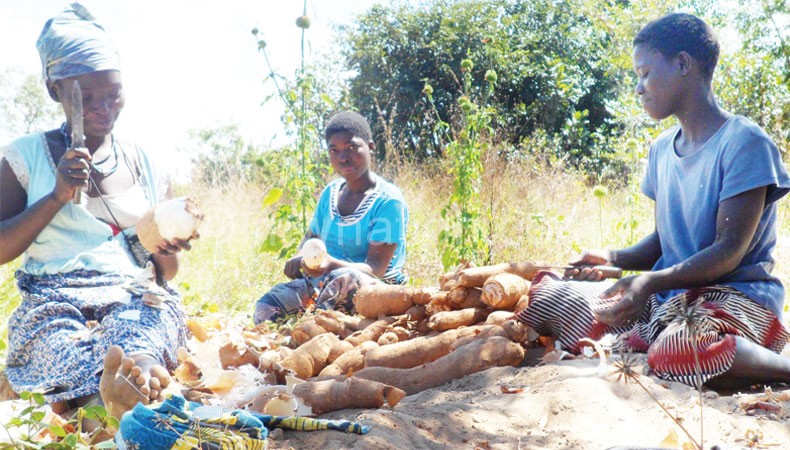Malawi’s biggest food puzzle

Today, with a population of 13 million, Malawi is already struggling to feed itself. Even with the expensive Farm Input Subsidy Programme (Fisp), millions still go without food in the country. Paradoxically, by 2030, Malawi’s population will almost double to 26 million. Where will Malawi get the food to feed such millions? EPHRAIM NYONDO writes
The fertile plains of Lirangwe in Blantyre could pass for identical twins with those in the area of Traditional Authority (T/A) Malanda in Nkhata Bay District.But they are twins with different products.For 14 years that Sella Manda, 38, has been growing cassava on a family land in the plains of Malanda, she has seen the best of yesterday and now she is living the worst.“Cassava is food here. We make our nsima out of it.
If you have it, you are food secured. If you don’t, you are in trouble. People do enjoy nsima from maize here,” she says while seated under a tree with her two in-laws peeling fresh cassava. “Our yields are low,” she complains, “We can’t cultivate the larger cassava as we used when I was a girl because the plant is always being attacked by pests. This is affecting our food choices”. Locals like Manda end up looking for maize which barely grows well here. “It is not just expensive to buy maize at the market, but it is also tasteless,” she says, attracting vigorous nods from her in-laws. When she got married to Manthonya Manda, the third born in the family of eight, they were allocated a portion in the family land where they started growing cassava for food. That was in 1991. Since then, pressure on the family land has increased because Manthonya’s four brothers, with years, also tied knots.
To mean, they had to share the family’s land. With increased overreliance on the same piece by a growing size of the family, coupled with the climate change which has altered weather patterns in the area, battered by the family’s failure to access new cassava seedlings which matures quickly and are drought-resistant, Manda is worried about her five boys. “I have six children. But I am worried about the boys because the girl will be married and taken away. It is these boys who will want a share in the land we are using. But the land appears tired. It is not producing so much,” she says.The fear for the future which Manda is expressing in Nkhata Bay can also be heard 569 kilometres away in the once fertile plains of Lirangwe in Blantyre.Once the food basket feeding Blantyre City residents, Malawi’s major commercial hub, Lirangwe locals like Ernest Mwanoka are struggling to produce enough maize to feed their families.“The land is starved of fertility,” he says, adding: “the rains are erratic. If we cannot access fertilisers, we are doomed.”
Forty-seven years old Mwanoka recalls late 1980s to mid-1990s as the glorious past of great harvests.“My best, and probably, the best year of maize harvest was 1999. Even though I applied quite few fertiliser, I managed 80 bags (50 kg bags),” he says.Since then, Mwanoka recalls that it was in 2007 when, at least, he managed to harvest 15 bags. That was because he had received a bag of fertilisers courtesy of Fisp.Otherwise, he rarely harvests more than 10 bags to feed the family of eight that he has.Just like Manda, Mwanoka is faced with a strenuous question: will he be able to feed to support his family in coming years?The food puzzle which Mwanoka and Manda are struggling with does not end with them.
It is a puzzle facing the entire nation today. Currently, there are 13 million people in Malawi and government, since 2005, has been investing heavily, through Fisp for smallholder farmers, to achieve food security not on the national level but, most importantly, on the household level.Yet still the intended foo security was not achieved. For instance, in the 2011/2012 national budget, government allocated K17.4 billion to Fisp. The goal was to achieve food security for the 2012/2013 consumption season.That did not happen. In October 2012, the Malawi Vulnerability Assessment Committee (Mvac) forecast showed that from April 2012 to March 2013, an estimated total population of 1.6 million will need food assistance. To feed such people, the United Nations and other aid agencies put together a cluster-based response to a tune of more than $100 million (about K40.7 billion then).
Now if government invests K17.4 billion to ensure food security, but the investment results in 1.6 million of its citizens food insecure, as a result needing K40.7 billion to be rescued, is Fisp really an answer to Malawi’s food puzzle? The tragedy of it all is that, currently, Fisp is being considered as the available solution to the country’s food problem. But big questions still remain: If Fisp is failing to feed 13 million Malawians, what will happen when Malawi’s population doubles to 26 million by 2030?“We completely need new ways of producing food to meet such a projected big demand,” says Tamani Nkhono-Mvula, national director Civil Society in Agriculture Network (Cisanet).He adds that finding new ways of producing food to meet the demands of a rising population needs a careful analysis of current shortfalls. Research shows that even with Fisp, food production in Malawi is beset by many factors.
“With climate change, our farmers continue to cultivate on small pieces of a depleted customary land leading to less productivity—something which is complicated with the use of unimproved seeds which are prone to pests and drought,” says Emmanuel Buleya, a graduate of Lilongwe University of Natural Resources (Luanar). To mean, in a Malawi experiencing a deadlock on land redistribution, food growers like Mwanoka and Manda need to find ways where, using their small pieces of customary land, they can rise above the challenge of climate change and increase their food productivity. But how can they achieve that?





